- Yummy top
- Eateries and restaurants
- Uoyu - lunch restaurant
- Kanno
- Tokachiya
- Kitchen Nankai - Jinbocho
- Lamb Meat Tender
- Fujiyoshi - tempura restau.
- Enda - Japanese blue crab
- Fukuda - globefish pot
- Sugimoto
- Fuushi
- Soba restaurant
- Shinano - Akabanebashi
- Juwari-soba Inamuraya
- Ando and Korin
- Toranomon Sunaba
- Izakaya
- subLime and Kakinoki
- Donburi-bachi
- Renka
- Yoshida
- Daini-Chikarashuzo
- Sasagin
- Mugiya - soba izakaya
- Fukube
- Sasashin in Ningyo-cho
- Foreign cuisine
- Pizza Piazza
- Atelier de Fromage
- La Piccola Tavola
- Milieu - salad lunch
- Cafe Moskow - Spanish bar
- Sin Tong Kee
- Sekaihanten
- Miscellaneous
- Cheese & champignon party
- Natural Cheese Contest
- Donburi - rice bowl dish
- Home cooking
- Aji no nanban-zuke
- Spaghetti Carbonara
- Curry rice
Maguro-don Kanno
Tsukiji 4-9-5, Chuou-ku, 104-0045 TokyoTel: 03-3451-2588
Open from 5:30 to 14:30 - Sundays and Holidays closed
Kanno - Tuna bowl
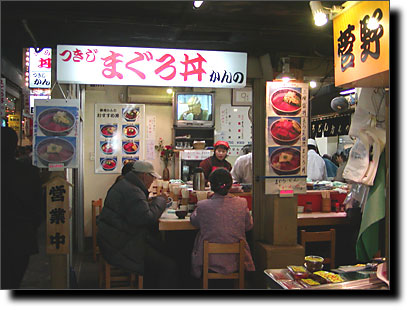
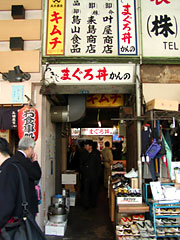
This narrow alley leads to Kanno.
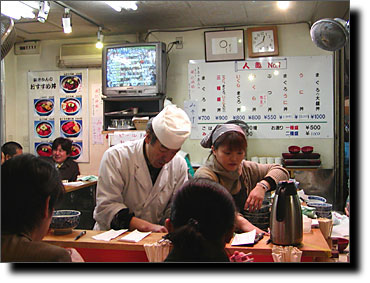
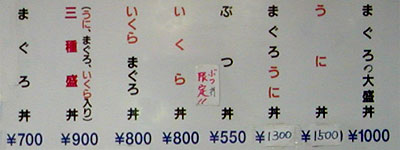
The menu of Kanno hanging on the wall - The cheapst bowl costs only 550yen.
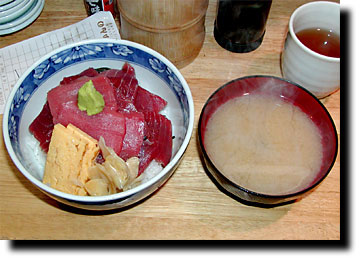
 Monzeki street is the boundry of the market. |
-
(1) "Jougai" means "outside the arena". In this case, "Tsukiji Jougai Market" is a sort of annex to the Tokyo Central Wholesale Market (colloquially "Tsukiji Fish Market"). In the Jougai Market there are shops for fish and fish related products which not only fishmongers but also visitors can buy. There are also various restaurants for the workers in the Tsukiji Fish Market and visitors from outside.
(2) Several years ago it was officially decided to move the Tsukiji Fish Market to Toyosu, which is located some 2.5 Km eastwards from Tsukiji. However, heavy metal pollution was found recently from the place where the Market shall have a new site and the discussions are still going on about the appropriateness of the move.
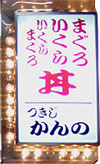 Electric sign of Kanno |
- (3) Chinese style soup noodle.
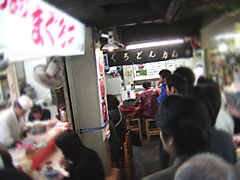 Relatively short queue of today |
I ordered today a slightly gorgeous meal - a "large tuna bowl" (1000 yen) and a "miso soup" (100 yen). By the way a young man who was queuing up in front of me ordered in the same ones. When the bowl was served, I counted the number of tuna slices. Thirteen thick slices were on top of the rice; a half of them were half-toro(4) and others were akami(5). Even the ordinary portion (700 yen) has enough volume for a lunch. Therefore, the large bowl, which has just more tuna slices, is really solid. Stir the horseradish into the soy-sauce, pour the hot sauce onto the tuna bowl and start to eat. The taste of tuna, soy-sauce and horseradish is combined with the best quality Koshihikari rice from Chiba Prefecture. It makes me truly happy.
-
(4) "Toro" means the belly meat of tuna. It is fatty and yummy. Oo-toro (literary means great toro) is more fatty and chu-toro (half toro) is less fatty.
(5) "Akami" is on the contrary lean part of tuna meat.
As there are many popular eateries in the Jougai Market and the Tsukiji Fish Market, I would like to try them. One thing we have to bare in mind in doing so is that we might be disappointed, if we would too much depend on the eatery review by media. An eatery that is taken up by a magazine might have a long queue of waiting guests who might have gathered the same information from the same magazine. But, the real quality of the food could be disappointing. If we would like to eat something delicious, we have to take a risk by ourselves. And, taking a risk in gourmet matters is simply a pleasure. I think I should train my senses, so that I can make an appropriate judgement just by seeing eateries from outside and without actuary trying their foods!
As for eateries in the Tsukiji Jougai Market, there is an Internet site that is fully loaded by various contents made by volunteers of the Market. I was very much impressed by a historical study in that site done by the students of Hosei University (Tsukiji - change of the town seen from Komiyama shop). It is worth reading, if you want to enjoy Tsukiji.